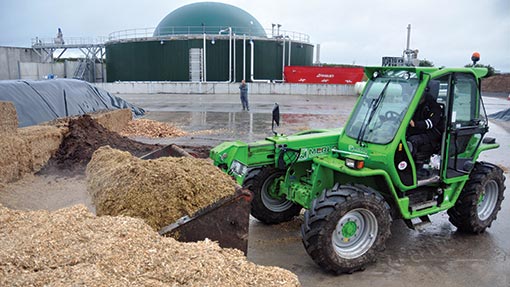The rye way to feed your anaerobic digester

Shropshire grower Guy Davies is moving to growing more hybrid rye to feed his anaerobic digester due to its reliability and high yields.
Some growers are finding this cereal crop more consistent whatever the season and have been impressed by its high dry matter yield.
The biogas plant on Mr Davies’ farm came on stream last month and he is growing rye alongside maize and energy beet to spread his risks.
“Digesters are like stock, they both like a varied diet, and hybrid rye has been easy and cheap to grow,” he says.
This is his first year growing rye and he has been impressed by its high dry matter yield, earliness to harvest and low production costs as maize is becoming more expensive to grow.
His hybrid variety crop yielded almost 45t/ha at 36% dry matter, and he is so impressed he will more than double his crop area this autumn.
The rye is yielding around the same as maize but offers an early harvest, can be drilled in the autumn and can be grown with existing cereal-growing machinery, Mr Davies adds.
He grew 24ha of the variety Magnifico from breeders KWS this year and is now preparing to increase his drilling area to 60ha.
His biogas plant is currently running off maize, stock-feed potatoes and poultry manure, and he is looking to introduce hybrid rye to the mix.
Mr Davis grew maize last season on his 1,100ha mainly arable farm at Red House, Little Ness, Baschurch, some six miles north west of Shrewsbury.
This maize crop was clamped last autumn in readiness for the digester coming on stream but he is keen to use other feedstocks for the microbes in the digester.
“It’s generally a cheap crop to grow, apart from the seed, and with a good yield we are very pleased,” he says.
Breeder KWS says its varieties Magnifico and Progas have recorded yields up to 35-40% ahead of whole crop winter wheat, such as the group’s variety Santiago.
The company’s energy crop specialist Simon Witheford adds that hybrid rye can show some of the highest dry matter yields compared with other crops.
He says hybrid rye is more vigorous than other varieties and has a high-tillering capacity, and so can keep blackgrass down when the rye crop is cut in July.
“First off it smothers the weed, then, if you can cut the rye and remove the blackgrass head before it has set seed, you can effectively cut levels of the weed in future crops,” he says.
Hybrids work well with maize
Herefordshire agronomist Richard Watkins says the use of hybrid rye in conjunction with maize can increase methane production in digesters.
He says that hybrid rye along with energy beet are clear alternative crops to consider along with maize for digesters.
The dry matter yield of hybrid rye can match that of maize, especially where soil fertility is low and maize crops may struggle.
Mr Watkins, who works for advisory and distribution group Hutchinsons, says there are a number of varieties to choose.
“There are two breeders with good products to select from, each variety offering features around the key characteristics of output and maturity, Magnifico and Progas from KWS and Saaten Union’s SU Drive and Generator,” he says.
He see a number of advantages of hybrid rye:
- It is a crop that can be grown using existing farm equipment.
- Agronomy is relatively simply, with nitrogen inputs applied at lower rates in most cases than other cereal crops.
- Foliar disease resistance is also good, therefore requiring less fungicide inputs.
- Sowing times fit well with other cereal crop establishment, and the crop will do well in more drought-prone soils. Being a hybrid, it roots are very vigorous and will extract more soil moisture and nutrition by scavenging more rigorously.
- Rye can also provide a good break in the cereal rotation, being less susceptible to eyespot and take-all.

